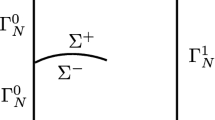Abstract
In this paper, we examine the response of a crack tip in an electrically conducting material subjected to a combination of mechanical load as well as a high density electrical current. We present a detailed examination of the process of evolution of melting and ejection, as revealed by high speed photography. The critical mechanical and electrical parameters that govern crack extension are then determined for two different alloys. Finally, we present an evaluation of the phenomenon through a coupled field simulation to examine the nature of the interaction between the electric field and the thermo-mechanical response.
Similar content being viewed by others
References
Doelp GGS (1984) Experimental and numerical analysis of electric currents and electromagnetic blunting of cracks in thin plates. MS Thesis, Cornell University
Finkel VM, Golovin YI, Sletkov AA (1977) Disintegration of a crack tip with a stron electromagnetic field. Sov Phys Doklady 22: 683–685
Gallo F, Satapathy S, Ravi-Chandar K (2009) Melting and cavity growth in the vicinity of crack tips subjected to short-duration current pulses. IEEE Trans Magn 45: 584–586
Landis CM (2004) Energetically consistent boundary conditions for electromechanical fracture. Int J Solids Struct 41: 6291–6315
Mukherjee S, Morjaria MA, Moon FC (1982) Eddy current flows around cracks in thin plates for nondestructive testing. J Appl Mech 49: 389–392
Satapathy S, Stefani F, Saenz A (2005) Crack tip behavior under pulsed electromagnetic loading. IEEE Trans Magn 41: 226–230
Simmons RO, Baluffi RW (1959) Measurements of the high-temperature electrical resistance of aluminum: resistivity of lattice vacancies. Phys Rev 117: 62–68
Tada H, Paris PC, Irwin GR (1973) The handbook of stress intensity factors. Del Research Corporation, Hellertown, PA
Tucker TJ, Toth RP (1975) EBW1: A computer code for the prediction of the behavior of electrical circuits containing exploding wire elements, Sandia National Laboratories Report # SAND-75-0041
Zhang TY, Wang T, Zhao M (2003) Failure behavior and failure criterion of conductive cracks (deep notches) in thermally depoled PZT-4 ceramics. Acta Materialia 51: 4881–4895
Author information
Authors and Affiliations
Corresponding author
Electronic Supplementary Material
The Below is the Electronic Supplementary Material.
ESM 1 (MPG 23032 kb)
Rights and permissions
About this article
Cite this article
Gallo, F., Satapathy, S. & Ravi-Chandar, K. Melting and crack growth in electrical conductors subjected to short-duration current pulses. Int J Fract 167, 183–193 (2011). https://doi.org/10.1007/s10704-010-9543-0
Received:
Accepted:
Published:
Issue Date:
DOI: https://doi.org/10.1007/s10704-010-9543-0




